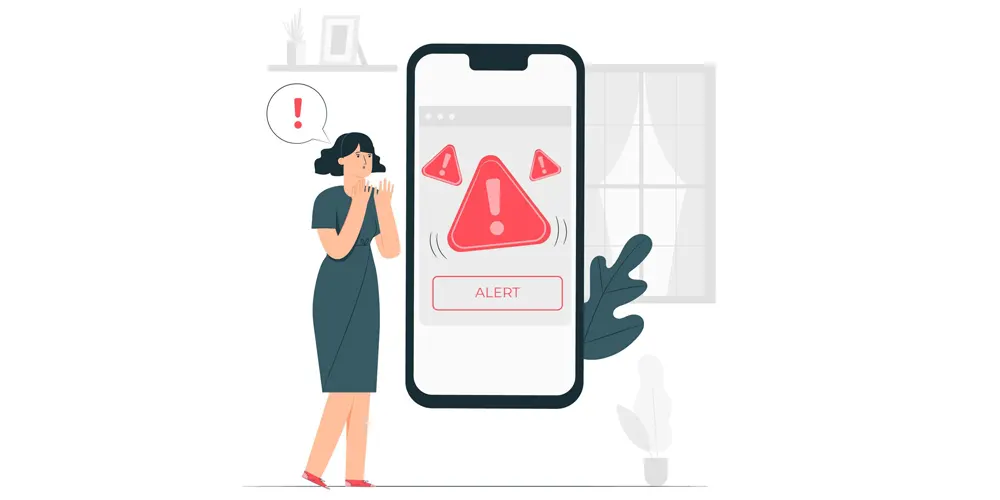The Anatomy of Robocall Scams
As long as there have been technological advances, there have been scammers who have come up with ways to misuse it for their gains. With every year and advancing technology, scammers’ access to unsuspecting victims has only increased.
The latest addition in this sea of scams has been that of robocall scams. Realistic AI-generated voice and the ability to spoof numbers and place millions of calls with a click have been a menace to our society.
With every American getting at least one scam robocall a day and victims losing about $1000 to every successful scam, it would be careless to not know or understand these.
In this blog, we will cover everything you need to know about Robocall scams. Doesn't matter if you’re a common American or a VoIP Carrier, this knowledge will help you keep yourself and your business safe.
Let’s get started with some basics then, shall we?
What are Robocalls?

Robocalls are automated phone calls made using computerized auto-dialers that deliver pre-recorded messages to a large number of recipients.
These calls are often used for various purposes, including telemarketing, political campaigning, public service announcements, etc.
Unfortunately enough, Robocalls are also frequently used to carry out fraudulent activities such as scams and phishing attempts.
Robocalls can be highly efficient for reaching a large audience quickly. This makes them an ideal choice for scammers to deceive individuals into providing sensitive information or engaging in fraudulent schemes.
What are Robocall Scams?

Robocall scams refer to deceptive schemes conducted through automated phone calls (robocalls). The intention is to defraud individuals or organizations.
These scams often involve pre-recorded messages that attempt to trick recipients into providing personal information. This can include financial details, passwords, or Social Security numbers, or convincing them to make payments for fake services or products.
Here are the key components of a Robocall Scam.
Automated Calls (Robocalls)
Robocalls are phone calls made using automated dialing systems. They can rapidly deliver pre-recorded messages to a large number of phone numbers.
These calls can be initiated at minimal cost by scammers, allowing them to reach a broad audience easily.
Deceptive Content
The messages delivered through robocall scams are often designed to create a sense of urgency, fear, or excitement. The primary aim here is to prompt immediate action from the recipient.
Scammers may claim to be representatives from government agencies, financial institutions, utility companies, or well-known businesses. They will often provide false information to manipulate victims and gain their trust.
Caller ID Spoofing
Robocall scammers often use caller ID spoofing techniques to disguise their phone numbers. Their objective is to make the calls appear to originate from legitimate sources or local area codes. This tactic increases the likelihood of recipients answering the calls.
Phishing and Identity Theft
Many robocall scams aim to gather sensitive personal information from victims, such as Social Security numbers, bank account details, or login credentials. This information is then used for identity theft, financial fraud, or other malicious purposes.
Thus, when all these components work in unison, they can impact the victims severely. Robocall scams can have severe financial, emotional, and psychological consequences for victims who fall prey to these schemes.
In addition to financial losses, victims may experience stress, anxiety, and a loss of trust in legitimate institutions and communications.
So how does everything look for robocall scams at present? Let me give you a brief idea.
State of Robocall Scams in 2023

3.34 Billion Robocalls were made just in December 2023 as per a report by Robokiller.
The same report states that the state of Texas is the top target for most robocall scams. It received a total of 4.3 billion scam robocalls in 2023. The most affected area codes received an average of 30 million scam robocalls in the last month of 2023.
Another report by Truecaller states that an American receives 31 spam calls on average every month. That’s one call every day trying to scam you.
Nasdaq reports that scam robocalls have grown 116% since the last year and the trend seems to point to a further increase moving forward.
The same report also pointed out that tier 1 carriers have been actively trying to mitigate scam robocalls. T-Mobile reported to have blocked 41 billion scam robocalls last year.
Healthcare scams have now overtaken car warranty scams. The latter witnessed a decline of 37% as the year progressed. So beware of scammers telling you that you need a better insurance plan or better medicines.
51% of respondents in a study conducted by Truecaller reported that Neighbour Spoofing has increased in the recent year. So make sure to not believe anything from a local phone number that seems even slightly misleading.
If you want to stay safe, it's better to know what to expect from robocall scams. For that, it would be really helpful to learn the different types of robocall scams.
Types of Robocall Scams
We’ll take a look at the different types of robocall scams. The ones we are to learn about are the most common and effective ones at present.
1. IRS Scams

Scammers impersonate IRS agents and claim that the recipient owes unpaid taxes or has outstanding tax issues.
They threaten legal action, such as arrest or deportation, if immediate payment is not made. The IRS does not initiate contact via phone calls for tax issues without prior communication via mail.
2. Social Security Administration (SSA) Scams

Fraudsters pose as SSA representatives and inform recipients that their Social Security numbers have been compromised or suspended due to suspicious activity.
They request personal information or immediate payment to reactivate Social Security benefits. The SSA does not suspend Social Security numbers without prior investigation and communication via mail.
3. Utility Company Scams

Scammers impersonate representatives from utility companies and threaten to disconnect services due to unpaid bills or overdue payments.
They demand immediate payment via wire transfers or prepaid cards. Legitimate utility companies communicate billing issues via mail and provide options for payment through official channels.
4. Tech Support Scams

Fraudsters pretend to be tech support agents from reputable companies like Microsoft or Apple. They claim that the recipient's computer is infected with viruses or experiencing technical problems and offer to fix it remotely for a fee.
5. Financial Institution Scams

Scammers impersonate bank employees or credit card companies and inform recipients of suspicious activity on their accounts.
They request personal information or payment to resolve the supposed issues. Legitimate financial institutions do not make unsolicited calls requesting personal information or payments.
6. Healthcare Scams

Scammers offer fake health insurance plans or promote unproven medical products claiming to cure diseases.
They exploit individuals' health concerns to solicit payments or personal information. Legitimate healthcare providers do not make unsolicited calls offering insurance plans or medical products.
These are some of the most common types of robocall scams that target individuals with various deceptive tactics. It's essential for individuals to remain vigilant, and recognize the red flags.
But how do the scammers get you to believe their lies so effectively? There’s a lot of psychology backing their scam strategies. Let’s take a look at some of these tactics!
Common Psychological Tactics Employed by Scammers
Scammers use various psychological tactics to execute robocall scams effectively. We shall learn about these to better understand how robocall scams are executed.
1. Fear and Threats

Scammers instill fear in recipients by making threats of legal action, arrest, or financial consequences if immediate action is not taken.
For example, they may claim to be from government agencies like the IRS or Social Security Administration and threaten legal consequences for unpaid taxes or suspicious activity.
2. Urgency and Pressure

Scammers create a sense of urgency and pressure recipients to act quickly without thinking rationally. They may claim that there is an emergency or time-sensitive issue that requires immediate attention.
These could be in the form of utility service disconnection or a pending legal matter.
3. Authority and Trustworthiness
Scammers often impersonate trusted entities, such as government agencies, financial institutions, or well-known companies, to gain recipients' trust and credibility.
By posing as authority figures or representatives from reputable organizations, they increase the likelihood of victims complying with their demands.
4. Social Engineering and Manipulation
Scammers use social engineering techniques to manipulate recipients into disclosing personal information or making payments.
They may exploit social norms, reciprocity, or empathy to establish rapport and gain victims' confidence, making them more susceptible to the scam.
5. Promises of Rewards or Benefits

Scammers entice recipients with promises of rewards, prizes, or benefits to encourage them to engage further in the scam and act quickly.
They may claim that the recipient has won a lottery or sweepstakes prize, offering a lucrative reward in exchange for payment of taxes or fees.
6. Confusion and Misdirection
Scammers intentionally create confusion or misdirection to distract recipients from questioning the legitimacy of the call.
They may use technical jargon, convoluted explanations, or rapid speech to confuse victims and prevent them from critically assessing the situation.
7. Emotional Manipulation
Scammers exploit recipients' emotions, such as greed, curiosity, or empathy, to elicit desired responses.
They may appeal to recipients' desires for financial gain, curiosity about unsolicited offers, or sympathy for fabricated personal stories to manipulate their behavior.
By employing these psychological tactics, scammers effectively deceive and manipulate recipients in robocall scams.
It's essential for individuals to remain vigilant and recognize the signs of manipulation. They should refrain from providing personal information or making payments to unsolicited callers.
Now you know what robocall scams are and why they are so effective. Let’s now find out how they impact consumers and businesses.
Impact of Robocall Scams on Consumers and Businesses

Robocalls, while seemingly just annoying interruptions have a much darker side as tools for sophisticated scams.
These scams inflict significant harm on both consumers and businesses. They cause financial losses, emotional distress, and operational disruptions.
Consumer Impact

Losing your hard-earned money is just one adverse impact of robocall scams. Let’s have a look at other negative impacts of robocall scams.
Financial Losses
The Federal Trade Commission (FTC) estimated that Americans lost a staggering $36.6 billion to phone scams in 2022, with robocalls being a major contributing factor.
The median individual loss from these scams was $1,485, highlighting the significant financial burden they place on victims.
Identity Theft
Robocall scams often aim to extract personal information like Social Security numbers, credit card details, or login credentials.
In 2022, identity theft complaints accounted for 21% of all FTC complaints, indicating the prevalence of this risk.
Emotional Distress:
The fear, anxiety, and frustration caused by these scams can have a lasting emotional impact on victims.
Scams targeting older adults are particularly worrisome, as they may be more vulnerable to manipulation and emotional distress.
Business Impact

A distracted workforce can run a business aground. Robocall scams don’t just distract your workforce but also have other negative impacts on them such as mentioned above.
Lost Productivity
Businesses receive a disproportionate number of robocalls, disrupting employee workflows and reducing productivity.
A 2020 study found that employees spend an average of 16 minutes per week dealing with robocalls, costing businesses an estimated $2.3 billion annually.
Damaged Reputation
Spoofed calls claiming to be from a business can erode trust and damage brand reputation, especially if customers lose money to the scam.
This can be particularly impactful for smaller businesses that rely heavily on customer trust.
Operational Costs
Businesses incur costs implementing call-blocking solutions, training employees, and responding to customer complaints related to robocalls.
As per this report by Infinity, on average, a business incurs almost $23,000 in increased operational costs combating robocalls.
With that, you now know everything about robocall scams. Let’s wrap up then.
Conclusion
New technology and malice are a combination causing pain to the world for ages. Every time new and advanced capabilities are introduced, someone, somewhere will find a way to use them unethically for their gains.
Robocall scams are just one example of this age-old quest of scamming people using technology. The good thing is that now you know how they work and how they intend to steal your hard-earned money.
We hope this blog helped you understand robocall scams thoroughly and we hope this knowledge helps you stay safe!
























































































































